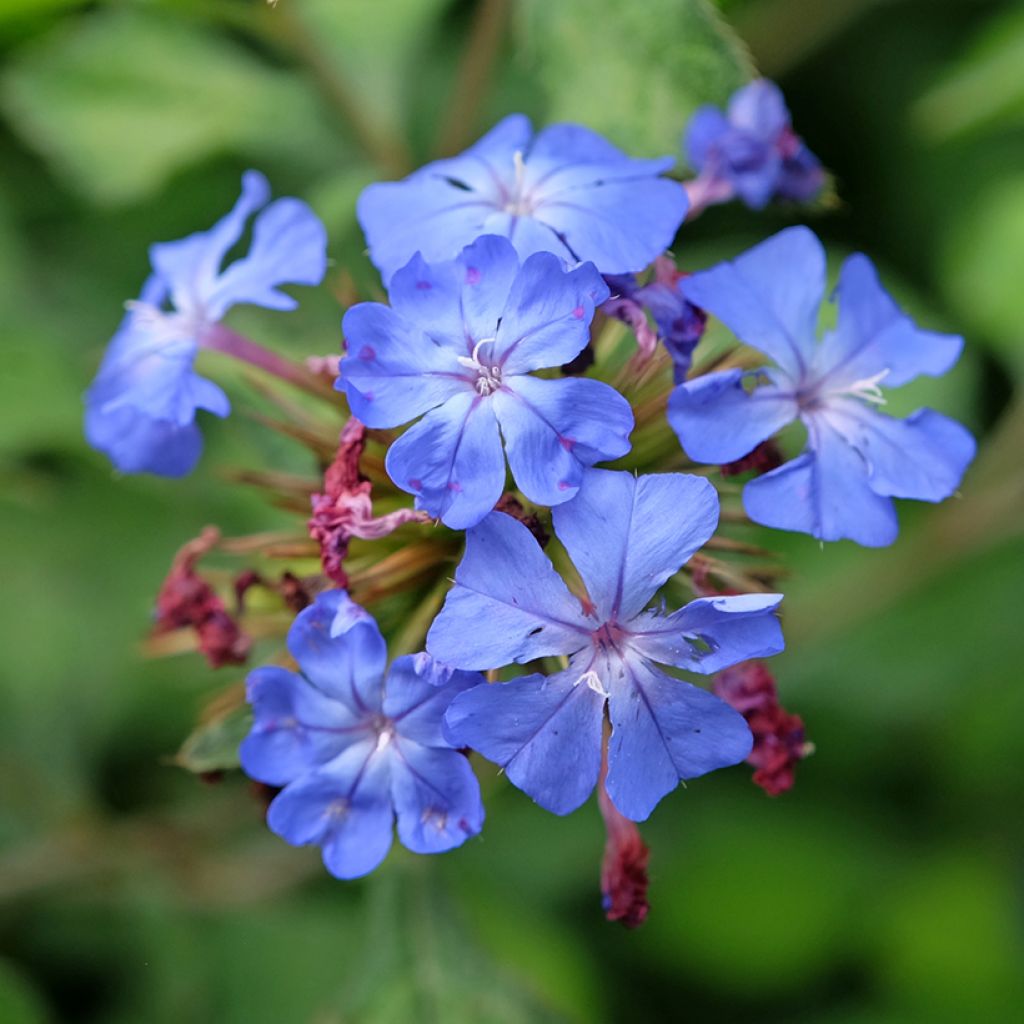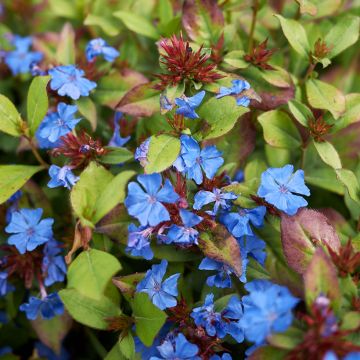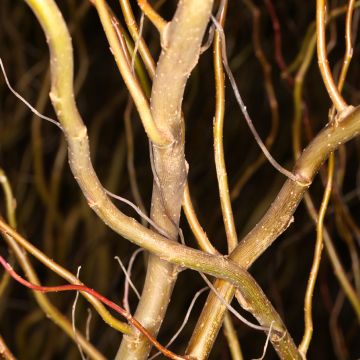

Ceratostigma willmottianum FOREST BLUE


Ceratostigma willmottianum FOREST BLUE


Ceratostigma willmottianum FOREST BLUE


Ceratostigma willmottianum FOREST BLUE
Ceratostigma willmottianum FOREST BLUE
Ceratostigma willmottianum Forest Blue
Chinese plumbago, Hardy plumbago, Blue plumbago, Leadwort, Willmott's plumbago
The plant arrived in very good condition. It immediately rooted well and started flowering. 3 years later, the plant has quadrupled in size. Its sapphire flowers are beautiful.
florence, 10/10/2024
Special offer!
Receive a €20 voucher for any order over €90 (excluding delivery costs, credit notes, and plastic-free options)!
1- Add your favorite plants to your cart.
2- Once you have reached €90, confirm your order (you can even choose the delivery date!).
3- As soon as your order is shipped, you will receive an email containing your voucher code, valid for 3 months (90 days).
Your voucher is unique and can only be used once, for any order with a minimum value of €20, excluding delivery costs.
Can be combined with other current offers, non-divisible and non-refundable.
Home or relay delivery (depending on size and destination)
Schedule delivery date,
and select date in basket
This plant carries a 24 months recovery warranty
More information
We guarantee the quality of our plants for a full growing cycle, and will replace at our expense any plant that fails to recover under normal climatic and planting conditions.


Would this plant suit my garden?
Set up your Plantfit profile →
Description
Ceratostigma willmottianum FOREST BLUE ('Lice') is undoubtedly the most floriferous variety of all. In late summer to early autumn, it is adorned with a multitude of star-shaped flowers in an unprecedented cobalt blue. Its lovely dome-shaped habit makes it ideal as a ground cover and it works wonders in flowerpots and containers on a terrace. Place it in a warm and sheltered location.
Ceratostigma willmottianum, sometimes called Leadwort or Willmott's Plumbago, belongs to the Plumbaginaceae family. It is a deciduous shrub native to western China that appreciates sun, heat, and soils with a tendency towards limestone. It is hardy to around -12° C (10.4° F) in well-drained soil.
The cultivar 'Forest Blue' was recently selected in England for its cold resistance (about -14° C (6.8° F)), its more compact habit, and its abundant flowering. All these qualities have earned it recognition from the Royal Horticultural Society. It is a small shrub with a flexible habit, compact growth, and a slightly spreading and well-branched shape, reaching about 60 cm (23.6 in) in height and a little more in width. The foliage is deciduous, falling in late autumn and reappearing quite late in spring. The small leaves have an oval shape that approaches that of a diamond and are covered with hairs on the upper and lower surface. Their colour changes from medium green in spring and summer to red from September onwards. From July until the first frost, it produces a myriad of tubular flowers with 5 petals, in a particularly bright blue. In autumn, the reddish-purple foliage creates a beautiful contrast with the blue flowers.
'Forest Blue' is an excellent plant for sunny gardens or terraces. It will thrive in most regions, except the coldest and driest ones in summer. Growing it in pots allows you to protect it in a cold greenhouse for winter if necessary, but also to plant it with many summer-flowering annuals to easily create a very colourful display on a balcony or terrace. In the garden, for example, plant it with yellow flowers (Coreopsis 'Sunray', goldenrods, Helenium) or with the purple and pink stars of asters. Pink ground cover roses with slightly blurry shapes like The Fairy, Mareva or Emera will also enhance it, along a path or in front of taller shrubs.
Ceratostigma willmottianum FOREST BLUE in pictures




Plant habit
Flowering
Foliage
Botanical data
Ceratostigma
willmottianum
Forest Blue
Plumbaginaceae
Chinese plumbago, Hardy plumbago, Blue plumbago, Leadwort, Willmott's plumbago
Cultivar or hybrid
Other Ceratostigma
View all →Planting and care
Plant in well-drained soil, even limestone, in a sunny location and sheltered from cold winds. If the soil in your garden is heavy, clayey, and moist in winter, improve drainage by mixing gravel or river sand and compost. You can also plant it in a raised bed or rockery. This plant is easy to grow; only severe cold and excessive drought should be avoided. It can also be used in a pot, with a good potting soil enriched with slow-release fertiliser. Watering should be more regular in containers, allowing the surface of the substrate to dry a little between two waterings.
Although water-efficient, it is not suitable for very dry land.
Planting period
Intended location
Care
Planting & care advice
-
, onOrder confirmed
Reply from on Promesse de fleurs
Similar products
Haven't found what you were looking for?
Hardiness is the lowest winter temperature a plant can endure without suffering serious damage or even dying. However, hardiness is affected by location (a sheltered area, such as a patio), protection (winter cover) and soil type (hardiness is improved by well-drained soil).

Photo Sharing Terms & Conditions
In order to encourage gardeners to interact and share their experiences, Promesse de fleurs offers various media enabling content to be uploaded onto its Site - in particular via the ‘Photo sharing’ module.
The User agrees to refrain from:
- Posting any content that is illegal, prejudicial, insulting, racist, inciteful to hatred, revisionist, contrary to public decency, that infringes on privacy or on the privacy rights of third parties, in particular the publicity rights of persons and goods, intellectual property rights, or the right to privacy.
- Submitting content on behalf of a third party;
- Impersonate the identity of a third party and/or publish any personal information about a third party;
In general, the User undertakes to refrain from any unethical behaviour.
All Content (in particular text, comments, files, images, photos, videos, creative works, etc.), which may be subject to property or intellectual property rights, image or other private rights, shall remain the property of the User, subject to the limited rights granted by the terms of the licence granted by Promesse de fleurs as stated below. Users are at liberty to publish or not to publish such Content on the Site, notably via the ‘Photo Sharing’ facility, and accept that this Content shall be made public and freely accessible, notably on the Internet.
Users further acknowledge, undertake to have ,and guarantee that they hold all necessary rights and permissions to publish such material on the Site, in particular with regard to the legislation in force pertaining to any privacy, property, intellectual property, image, or contractual rights, or rights of any other nature. By publishing such Content on the Site, Users acknowledge accepting full liability as publishers of the Content within the meaning of the law, and grant Promesse de fleurs, free of charge, an inclusive, worldwide licence for the said Content for the entire duration of its publication, including all reproduction, representation, up/downloading, displaying, performing, transmission, and storage rights.
Users also grant permission for their name to be linked to the Content and accept that this link may not always be made available.
By engaging in posting material, Users consent to their Content becoming automatically accessible on the Internet, in particular on other sites and/or blogs and/or web pages of the Promesse de fleurs site, including in particular social pages and the Promesse de fleurs catalogue.
Users may secure the removal of entrusted content free of charge by issuing a simple request via our contact form.
The flowering period indicated on our website applies to countries and regions located in USDA zone 8 (France, the United Kingdom, Ireland, the Netherlands, etc.)
It will vary according to where you live:
- In zones 9 to 10 (Italy, Spain, Greece, etc.), flowering will occur about 2 to 4 weeks earlier.
- In zones 6 to 7 (Germany, Poland, Slovenia, and lower mountainous regions), flowering will be delayed by 2 to 3 weeks.
- In zone 5 (Central Europe, Scandinavia), blooming will be delayed by 3 to 5 weeks.
In temperate climates, pruning of spring-flowering shrubs (forsythia, spireas, etc.) should be done just after flowering.
Pruning of summer-flowering shrubs (Indian Lilac, Perovskia, etc.) can be done in winter or spring.
In cold regions as well as with frost-sensitive plants, avoid pruning too early when severe frosts may still occur.
The planting period indicated on our website applies to countries and regions located in USDA zone 8 (France, United Kingdom, Ireland, Netherlands).
It will vary according to where you live:
- In Mediterranean zones (Marseille, Madrid, Milan, etc.), autumn and winter are the best planting periods.
- In continental zones (Strasbourg, Munich, Vienna, etc.), delay planting by 2 to 3 weeks in spring and bring it forward by 2 to 4 weeks in autumn.
- In mountainous regions (the Alps, Pyrenees, Carpathians, etc.), it is best to plant in late spring (May-June) or late summer (August-September).
The harvesting period indicated on our website applies to countries and regions in USDA zone 8 (France, England, Ireland, the Netherlands).
In colder areas (Scandinavia, Poland, Austria...) fruit and vegetable harvests are likely to be delayed by 3-4 weeks.
In warmer areas (Italy, Spain, Greece, etc.), harvesting will probably take place earlier, depending on weather conditions.
The sowing periods indicated on our website apply to countries and regions within USDA Zone 8 (France, UK, Ireland, Netherlands).
In colder areas (Scandinavia, Poland, Austria...), delay any outdoor sowing by 3-4 weeks, or sow under glass.
In warmer climes (Italy, Spain, Greece, etc.), bring outdoor sowing forward by a few weeks.





















































